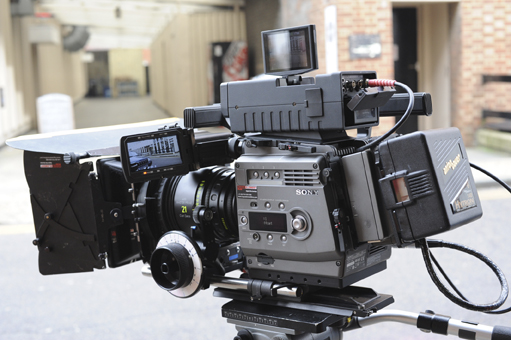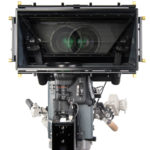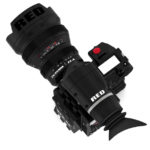
P2 Media For Drama Use
Posted on May 6, 2010 by Alex Fice
Panasonic P2 and Rogue Element Films look at 4.2.2 HDTV content delivery using Sony’s F35 and Thomson’s Viper
The acceleration of HDTV delivery and the need for that type of quality image capture has led Rogue Element Films to investigate other avenues of recording images for TV Productions. The costs of recording for some productions, allied to the rental of certain equipment for that style of recording, have proven to be somewhat prohibitive, although it’s probably the best way to capture the highest quality images possible along with uncompressed data via DPX frames. Other ways to capture these images have been seen to offer the most rounded solution for certain content delivery environments.
Most high end TV productions will be looking at two cameras per show for shooting which can double the stock purchase and also doubles the rental for equipment.
How do we reduce those costs but keep the quality of the images intact while delivering a cheaper and perhaps more efficient workflow option? These questions prompted us to look at the Panasonic P2 workflow usually reserved for ENG practices.
By using its AVC Intra 100 codec the P2 cards, via the HPG20 unit, we can record full 10bit 4.2.2 images from SDI cameras such as the Sony F35 and Thomson Vipers thus giving us the image quality but allowing us a much more cost effective data recording solution.
In this article I will explain the P2 workflow and show examples and explanations of why we at Rogue have adopted the P2 for such work.
Introduced by Panasonic in 2004 the P2 format is based around solid state media to capture varying levels of image data with differing codec values. By using the AG-HPG20 recording system we at Rogue are able to capture from the F35 full 10bit 4.2.2 1080 25p images into the AVC-Intra 100 codec.
Being only 1kg in weight we are able to attach the recorder to the camera allowing for an un-tethered recording system. Being a data workflow allows certain time efficiencies within your workflow and gives the production time and costs savings. So for HDTV content delivery we can capture amazing images from the F35 but retain a cost effective data workflow throughout saving time and money.
P2 Hardware
As the images show you here the HPG20 recording unit can be integrated into the F35 and thus create a completely self contained shooting and recording environment with a relatively small footprint. The P2 recorder can run from local power that is powering the F35 at the same time and enables as best we can a similar recording and power delivery system as the F900 keeping everything running of one battery and a self contained recording environment.
The HPG20 has a small LCD screen that can be used for verifying shots that have been captured and recording is controlled via a record button on the unit itself. P2 cards are needed to insert into the recorder and it has two available slots, allowing for a full card to be removed and then archived while a second card continues recording. Once the P2 recorder is set up then it’s a simple case of recording your takes all in 4.2.2 10bit 1080 25p.
P2 Software
Any data/card/hard drive recording system naturally relies on the software to drive the workflow from point A to B. In the case of the P2 system Panasonic have created a full software suite that caters for not only the capture codec but also the archive and delivery requirements needed.
The P2CMS (Content Management Software) caters for this. It’s a library for the rushes taken and each shot is issued a unique identifier that will enable a clip to be easily selected and viewed during conform. The CMS also allows the layout of each clip at full resolution and the ability to re-save any metadata that may have been missed during the actual shoot.
Archiving the rushes is simply a case of formatting an external drive into the P2 environment and then transferring the shot rushes across to the external drive using the actual HPG unit you have recorded from.
To re-cap then the P2 software and workflow revolves, in this example, around the AVC Intra 100 codec. This is the capture codec that best supports the F35/Vipers 10bit output at 4.2.2. This captured codec is then archived and then pushed through Panasonics CMS software suite to create your dailies and deliver the content to editorial to create your EDL. One major advantage of the native P2 format is its ability to be ingested into your edit suite in its native format thus removing the need to downconvert to another format to edit from and giving editorial the ability to see the same rushes in HD that you shot on set and removes another task from the workflow thus creating time and cost savings during production.
Testing On Set Workflow
We tested the workflow for the P2 thoroughly on a recent BBC show using the Viper and also the F35 workflow on a recent test for another HDTV show at Elstree Studios.
For the BBC show Last of the Summer Wine we recorded the 2010 series on the Viper connected to an SRW1 HDCAM SR field recorder. To test the viability of the P2 format we connected a P2 HPG20 recording device to the SRW1 4.2.2 output and recorded the same rushes we were recording to the SR format (see pictures of deck with SRW1). This enabled a true comparison to the SR masters and to see how easily the P2 system could be integrated into a real shoot on set.
The HPG20 recorder performed flawlessly and we had zero issues recording the images on set. In fact the size of the recorder itself gave us certain freedoms by enabling us to attach the recorder to the Viper camera head instead of being tethered to the SRW1 deck as normal. This gives recording control back to the DP/Operator and perhaps reduces the need for certain dedicated operations now seen on digital sets in such circumstances?
The images looked fantastic given the compression employed by the AVC Intra codec and looking at the results and given the ability to have un-tethered recording capability we would have no problem recommending the P2 to any production giving a real choice and a true alternative.
Final Analysis
By using the P2 card system and the HPG20 recording unit productions have the ability to capture high dynamic range images from the Viper or F35 in 4.2.2 colour space at full 10bit capture and as the delivery requirements would be for 16mb/s TV then its entirely viable given the delivery requirements. Data workflows using the P2 software and codecs then introduces significant cost and time savings and also retains the high image quality that the F35 delivers, it really is a fantastic way to save you time and money and give you the exceptional image quality that high end TV dramas now rightly insist on.








